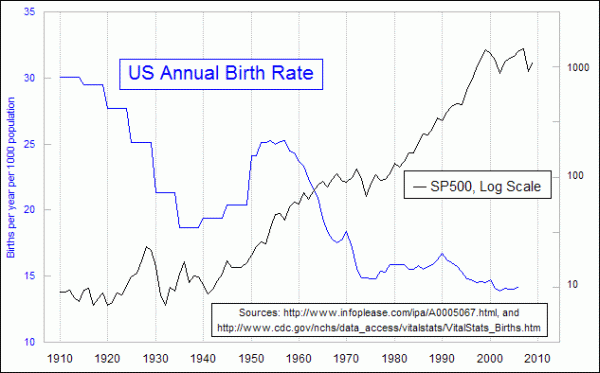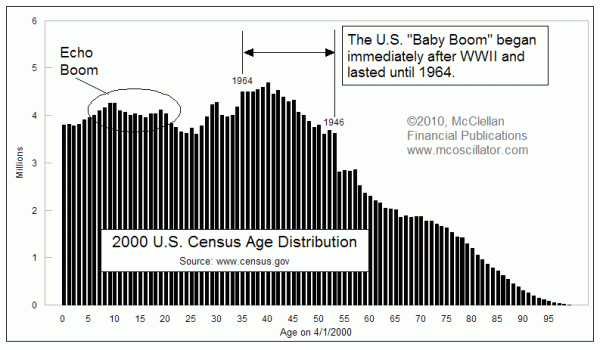Birth Rate and the Stock Market

Free Chart In Focus email
Delivered to you every week
I recently ran across some interesting data on the birth rate in the U.S., and noticed that there was a big bulge in that data during the 1940s through the 1960s. That is the same period when the U.S. stock market was in a big secular uptrend, so I thought it would be fun to do this comparison.
It is interesting to see the correlation between a rising birth rate and a rising stock market. Clearly, more babies must mean more economic growth!! Actually, if we think a little bit more deeply about what goes on behind these numbers, there are some useful insights.
This birth rate data looks at how many live births there are compared to the total population, and is measured in units of births per 1000 people. Experts will tell you that something like half of those 1000 people cannot ever give birth at all, since they are men. Of the other half (the women), only a fraction will be in their childbearing years at any given time. If certain conditions exist which magnify the numbers of women of childbearing age versus other women, that factor will show up in the birth rate numbers.
Other statistics look at birth rates in different ways, and you can see a ranking of countries according to "fertility rates" (children born per woman) at: CIA World Factbook.
There was a big dip in the U.S. birth rate during the Great Depression years of the 1930s, and this is where examinations of these data get complicated. Part of that dip in the birth rate was due to women electing not to have babies during a bad economic period, so there is a bit of a feedback mechanism involved in the relationship to stock price movements. But another part of the explanation for that dip likely has to do with the declining fraction of women of childbearing age at that time, and this is important. People of childbearing age also happen to be of the age that is most economically productive, so if there is a drop in that population group due to low births 20-40 years earlier, then there will also be a drop in economic productivity of the workforce. The echo of that low birth rate in the 1930s and 1940s was another low birth rate period in the 1970s.
The "Baby Boom" generation consists of people born from 1946-64, which is that big bulge in the birth rate near the center of the chart. When the 1980s arrived, those boomers were in their prime working years, and helped to push up both economic growth and stock prices. They also caused the birth rate to peak again in 1990.
The chart below shows that bulge in the population in another way, as measured in the 2000 Census. The bars show how many people there were in the US in each age group.

The reason why this age demographic profile is important now is because the boomer generation is now starting to retire. So their population bulge is transitioning from the production/saving age group into the non-producing portion of the population. Along the way, those boomers are going to want to sell their big houses and their investment portfolios to the younger people, and there are not as many of the younger people. For the sellers of assets to compete for the attentions of the smaller number of buyers, the sellers are going to have to accept lower prices.
That imbalance of sellers to buyers is going to have a depressing effect on investment asset prices for a long time. Starting in the 2020s, when the "echo boomers" hit their productive years, things should start getting better again, but until then the combination of boomers retiring and echo-boomers still being young and in school will keep people out of the "producers" portion of the population.
And that likely means we are in for a sideways market during the 2010s, much like what we saw in the 1970s and 1930s.
Tom McClellan
Editor, The McClellan Market Report
Jan 15, 2010 Stock Market Repeating the Sideways 70s |
Nov 06, 2009 Civilian Employment Level (Follow Up) |
Dec 11, 2009 Final Dip Coming For Housing Market |
Dec 18, 2009 Drop in inflation should bring DROP in crime |